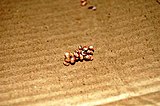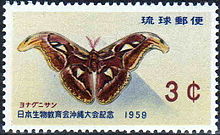Attacus atlas
| Atlas moth | |
|---|---|

| |
| Female | |
| Scientific classification | |
| Kingdom: | |
| Phylum: | |
| Class: | |
| Order: | |
| Family: | |
| Genus: | |
| Species: | A. atlas
|
| Binomial name | |
| Attacus atlas | |
Attacus atlas (Atlas moth) is a large saturniid moth found in the tropical and subtropical forests of Southeast Asia, and is common across the Malay archipelago.[1]
Atlas moths were often considered the largest moths in the world in terms of total wing surface area,[2] but recent sources confer this title upon the Hercules Moth from New Guinea and northern Australia.[3][4] Their wingspans are also among the largest, reaching over 25 cm (9.8 in). Females are appreciably larger and heavier than the males.
Atlas moths are said to be named after either the Titan of Greek mythology, or their map-like wing patterns. In Hong Kong the Cantonese name translates as "snake's head moth", referring to the apical extension of the forewing, which bears a more than passing resemblance to a snake's head.[5] Japan only has the A. a. ryukyuensis subspecies which is native to the Yaeyama Islands, principally Yonaguni, and as such is called the Yonaguni-san (ヨナグニサン《与那国蚕》, "Yonaguni silkworm"). It is said to be the inspiration for the movie monster Mothra.[6]
The largest lepidopteran in terms of wingspan is considered to be the White Witch, Thysania agrippina. A record specimen of Attacus atlas from Java measured 262 mm, while Thysania are documented to be about 290 mm or more.[1]
In India, Atlas moths are cultivated for their silk in a non-commercial capacity; unlike that produced by the related silkworm moth (Bombyx mori), Atlas moth silk is secreted as broken strands. This brown, wool-like silk is thought to have greater durability and is known as fagara.[7] Atlas moth cocoons have been employed as purses in Taiwan.[8]
Similar taxa
The term "Atlas moth" is sometimes used mistakenly as a name for any species in the genus Attacus, of which there are over 20 named species and subspecies. A few New World species can be mistaken for Atlas moths, specifically members of the genus Rothschildia. Very similar in appearance to the Asian Atlas moth, Rothschildia aurota is one of the largest members of its genus and a Neotropical relative.
Life cycle
| Holometabolism | ||||
|---|---|---|---|---|

|

|

|

|

|
| Eggs | Caterpillar | Pupa | Imago emerging from Pupa | Fully Grown |
Attraction
Females are sexually passive, releasing powerful pheromones which males detect and home in on with the help of chemoreceptors located on their large feathery antennae. Males may thus be attracted from several kilometres downwind.[9] Atlas moths are unsteady fliers, and the female does not stray far from the location of her discarded chrysalis: she seeks a perch where the air currents will best carry her pheromones.
Larva
Once mated, the female lays a number of spherical eggs 2.5 mm in diameter on the undersides of leaves. Dusty-green caterpillars hatch after about two weeks and feed voraciously on the foliage of certain citrus and other evergreen trees.[10] The caterpillars are adorned with fleshy spines along their backs which are covered in a waxy white substance.
Pupa
After reaching a length of about 115 millimetres (4.5 in), the caterpillars pupate within a papery cocoon interwoven into desiccated leaves. The adult moths emerge after about four weeks.
Adult
Adult Atlas moths do not have mouths, and as such only live for a few days.
Habitat

The habitat is primary tropical and subtropical dry broadleaf forests and shrublands but secondary forest is also utilised.
Gallery
-
Attacus atlas
-
Close up of the body
-
Close up of the scales
-
Rothschildia aurota, Neotropical relative of the Atlas moth

References

- ^ Holloway, J.D. (1987). The Moths of Borneo, part 3: Lasiocampidae, Eupteroptidae, Bombycidae, Brahmaeidae, Saturniidae, Sphingidae. Southdene Sdn. Bhd., Kuala Lumpur
- ^ Watson, A. & Whalley, P.E.S. (1983). The Dictionary of Butterflies and Moths in colour. Peerage Books, London, England. ISBN 0-907408-62-1
- ^ Robert G. Foottit & Peter H. Adler. 2009. Insect Biodiversity: Science and Society. Blackwell Publishing Ltd. ISBN 978-1-405-15142-9
- ^ Rainier Flindt. 2006. Amazing Numbers in Biology. Springer-Verlag, Berlin. ISBN 3-540-30146-1
- ^ Yiu, V. (2006). Insecta Hongkongica. Hong Kong Discovery. Kowloon, Hong Kong. 655pp. ISBN 988-97173-9-5
- ^ Yoda, Hiroko (2013-01-14). "Okinawa: Which island is for you? | CNN Travel". Travel.cnn.com. Retrieved 2013-06-08.
- ^ Jolly, M.S., Sen, S.K., Sonwalkar, T.N. & Prasad, G.S. (1979). Non-mulberry silks. Food & Agriculture Organisation. United Nations, Serv. Bull. 29. Rome. xvii + 178pp
- ^ S. B. Jugale; et al. (2010). "MAJOR INSECT PESTS OF XYLOCARPUS GRANATUM KOEN., A CRITICALLY ENDANGERED MANGROVE SPECIES OF MAHARASHTRA" (PDF). ISSN 0973-7049.
{{cite journal}}: Cite journal requires|journal=(help) - ^ Shepherd, G.M. (1994). "Chemical Senses". In Neurobiology 3rd Edition. Oxford University Press
- ^ Robinson, G.S., Ackery, P.R., Kitching, I.J., Beccaloni, G.W. & Hernández, L.M. (2001). Hostplants of the moth and butterfly caterpillars of the Oriental Region. Southdene Sdn. Bhd., Kuala Lumpur & The Natural History Museum, London. 744 pp. ISBN 983-40053-3-4




